What are the best website localization tools?
Website localization needs the use of many different tools. These tools make the life of a localization engineer much easier. WAPA Translations compiled this list of the best five website localization tools to use day-to-day.
5 Essential Website Localization Tools
CAT Tools
Computer-aided translation (CAT) tools are software solutions that help streamline the process of creating language assets like translation memory and translation glossaries as well as the process of translation. These tools generate optimized conditions for translation. Also, CAT tools integrate glossaries and translation memory into the localization workflow. When translators come across a term stored in the translation glossary or a sentence which is stored in the translation memory the translator is advised to use the options already stored in the language assets. These language assets allow your translation teams to use previously approved translations whenever possible consistently, so you don’t have to pay for a translator to do the same work over and over.
Translation Management Systems
A TMS is a vital resource that allows you to automate much of the translation process. API integration between your TMS and your CMS (content management system) enables your team to push selectively and pull text for translation with some mouse clicks, or automatically when new text is calculated. This tool lessens errors, saves time and lowers your costs. This includes costs you may not have examined such as the time and effort of your internal marketing team.
Centralized Language Assets
After content has been translated and localized, you can leverage the resulting language assets to save time and money on future translations. Creating a centralized translation memory database of all of your translations and a glossary of used words and phrases assures that your content is uniform across all of your sites and reduces the weight on translators. Because the glossary and translation memory is both centralized and accessible in real-time, you can be sure that everyone on the team has access to the most current and approved language preferences.
Quality Assurance Tools
Quality Assurance (QA) tools compare source files with final content to find errors. Some of the errors QA tools can catch include terms that are not consistent with the supported glossary, formatting errors, segments that were not translated consistently and content that has not been translated.
Human or Machine Translation
Beyond human translation services, website localization service providers also offer you with machine translation (MT). With a notable amount of content, MT with a human editor can be a more affordable choice to start the localization process for languages that are not in your priority language group. It also uses analytical techniques to improve upon the accuracy of its translations in the target languages.
Although these website localization tools are valuable, they can’t be used without the help of human experts. Even the best tool must be evaluated by a qualified translator to make sure that the outcome makes sense in context and helps improve the accuracy.







